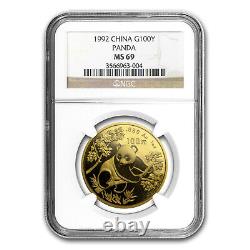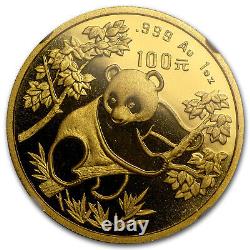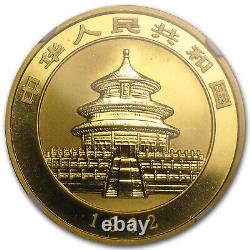1992 China 1 oz Gold Panda Small Date MS-69 NGC




1992 China 1 oz Gold Panda Small Date MS-69 NGC. Photos in this listing may or may not be stock photos. The photos are meant to be an indication of the product you will receive. NGC encapsulation guarantees the MS-69 condition of the coin. Mintage of 41,120 coins.
Obverse: Depicts the Hall of Prayer for Abundant Harvests in the Temple of Heaven in Beijing encircled by the phrase People's Republic of China in Chinese and the year of issue. This issue is a Small Date variety. Reverse: Features a panda holding onto a tree branch, with the weight and purity. Sovereign coin backed by the Peoples Bank of China. Display your Gold Panda in style by adding a nice presentation box. Add this Small Date 1992 1 oz Gold Panda coin to your cart today! The giant panda, also known as panda bear or simply panda, is a bear native to south central China. It is easily recognized by the large, distinctive black patches around its eyes, over the ears, and across its round body. The name giant panda is sometimes used to distinguish it from the unrelated red panda. Though it belongs to the order Carnivora, the giant panda's diet is over 99% bamboo. Giant pandas will occasionally eat other grasses, wild tubers, or even meat in the form of birds, rodents, or carrion. The giant panda lives in a few mountain ranges in central China, mainly in Sichuan, but also in neighboring Shaanxi and Gansu.As a result of farming, deforestation, and other development, the giant panda has been driven out of the lowland areas where it once lived. While the dragon has often served as China's national symbol, internationally the giant panda appears at least as commonly. As such, it is becoming widely used within China in international contexts. When people think of China, they often think of the panda.
The Chinese regard them as a symbol for friendship and peace. The panda has an important place in Chinese culture and history. In the Xizhou Dynasty, the panda was described as an invincible animal, as strong as a tiger. As a tribute to kings and emperors, a panda's pelt was often given during that time. During the Ming dynasty, the panda was often thought to have medical powers.The pelt supposedly could repel plague and prevent tumors. The panda is often compared to the yin and yang because of its black and white spots. The panda's calm demeanor is a demonstration of how, when balanced, the yin and yang are harmonious and peaceful. This is not a photo of the actual item.

